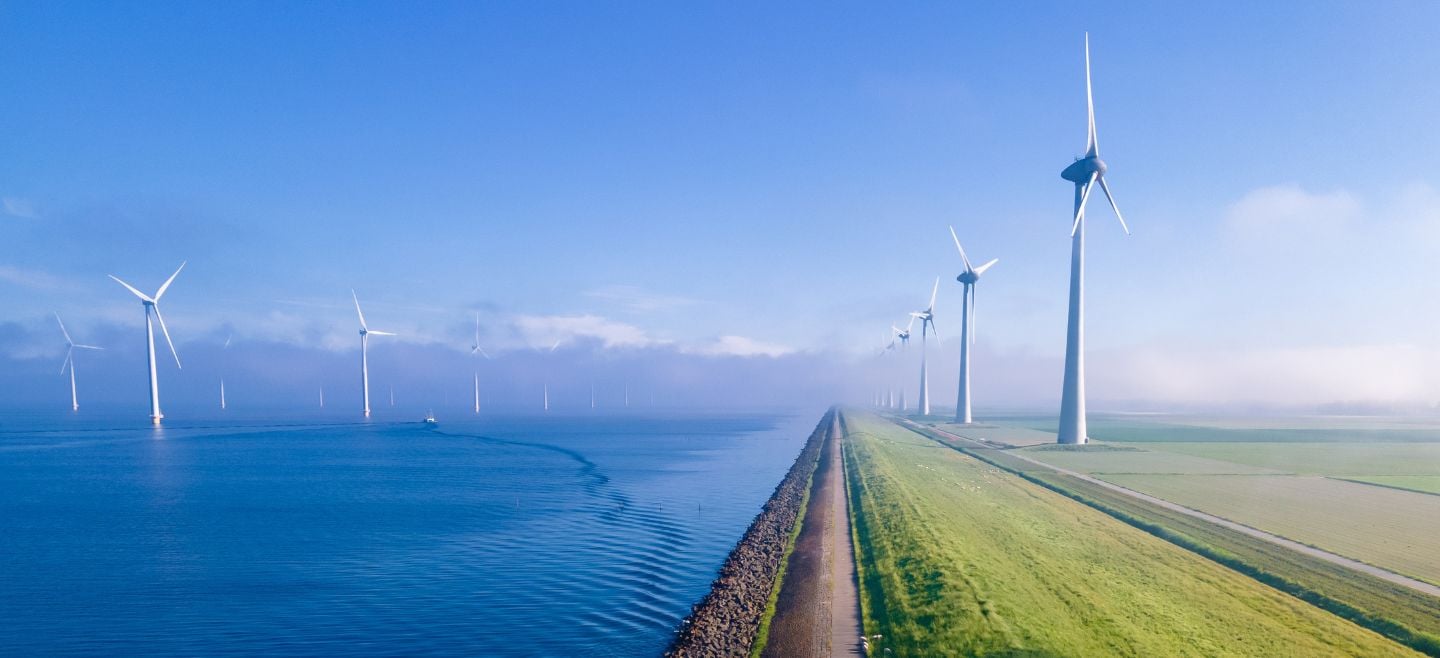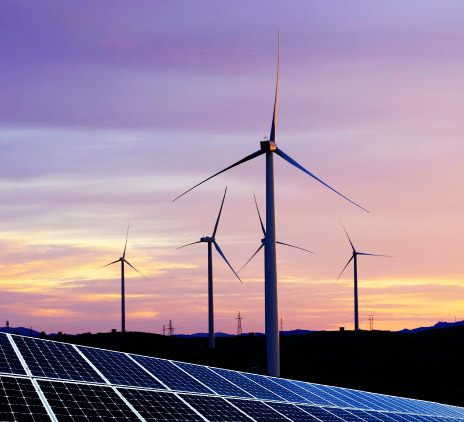We hope you find the information in this article helpful in giving you some insights about energy concerns. If you would like to discuss any of the points raised, please speak to your usual Grant Thornton contact or your local member firm and count on our ENR leaders.
Exploring opportunities for energy diversification amid climate action goals

This indicator reveals the perception of leaders in more than 30 countries. Therefore, an urgent need for energy diversification amid climate action goals is a discussion that has intensified.
Furthermore, the differences in energy costs and concerns among countries can be attributed to several factors, such as:
- Energy Sources: Countries rely on different energy sources. For example, nations with abundant renewable resources like hydro, wind, or solar may face different cost dynamics compared to those dependent on fossil fuels.
- Government Policies: Energy policies, subsidies, and regulations vary widely. Some governments may provide significant support for renewable energy, while others might still heavily subsidize fossil fuels.
- Infrastructure: The state of a country’s energy infrastructure can impact costs. Modern, efficient grids and facilities can reduce costs, whereas outdated infrastructure might lead to higher expenses.
- Market Dynamics: The energy market structure, including competition and market regulation, can influence prices. In some countries, energy markets are highly competitive, driving prices down, while in others, monopolies or limited competition can keep prices high.
- Economic Factors: Exchange rates, inflation, and overall economic health play a role. Countries with stronger economies might better absorb energy cost fluctuations compared to those with weaker economies.
- Geopolitical Factors: Political stability and international relations can affect energy prices. For instance, countries in politically volatile regions might face higher energy costs due to supply uncertainties.
- Climate and Geography: Natural conditions influence energy needs and costs. Countries with extreme climates may have higher energy demands for heating or cooling, impacting overall costs.
These factors create a complex scenario where energy costs and concerns can vary significantly from one country to another. Some countries already have an open market, allowing industries to negotiate energy costs through short- and long-term contractual agreements, as well as offering the opportunity to choose clean energy sources for their production.
In this article, you will find a detailed overview of the countries that already provide this possibility of negotiating energy costs and sources, as well as those that are progressing towards this goal through their targets.
Contries overview
The energy cost landscape in the United States saw significant changes from the end of 2023 to 2024, with energy costs representing 48% of total expenses in 2023 and rising to 61% in 2024. Globally, energy costs accounted for 52% in 2023 and increased to 55% in 2024. These variations highlight the dynamic nature of energy markets and the factors influencing them.
Factors driving changes in energy costs
Bryan Benoit, former head of Energy and Co-Global Head of Valuation at Grant Thornton International, commented that several key factors contributed to the observed changes in energy costs. “The global energy market faced instability due to disruptions in fuel supply chains, exacerbated by geopolitical tensions such as Russia's invasion of Ukraine. Furthermore, the surge in energy demand following the pandemic led to higher commodity prices represented by post-pandemic demand increase”.
It is notable that seasonal temperature variations and extreme weather events impacted energy consumption patterns. Bryan commented: “Integrating new technologies in energy production and consumption also played a role. Renewable energy sources, such as solar, wind, and hydropower, offer significant potential for reducing energy costs. By diversifying energy supply and reducing reliance on fossil fuels, renewables can stabilize energy prices and enhance energy security”.
Leveraging renewable energy for Sustainability and cost savings
Companies that align their business strategies with sustainability and climate goals can effectively leverage renewable energy to achieve cost savings and increase their environmental impact. Bryan says: “By investing in renewable energy technologies, businesses can reduce operational costs, enhance their brand reputation, and contribute to global sustainability efforts”.
The latest edition of the International Business Report (IBR), there was a 7-percentage point drop compared to the years ended 2023 to 2024, from 43% to 36%, and also indicates that Brazil is moving in the opposite direction of the global average, which increased from 52% to 55%.
According to Élica Martins, Leader of Energy and Natural Resources at Grant Thornton Brazil and Global Energy Content Chairperson at Grant Thornton International, this scenario reflects the search by entrepreneurs for alternative sources, mainly driven by the free energy market, which allows cost reduction through the autonomy of high-voltage consumers in choosing the ideal supplier.
Influence of climatic conditions
In addition to the free energy market, Martins also points out that climatic conditions are influential factors in the concern with energy costs. "In Brazil, where hydroelectric reserves represent our main source, years with good hydrological conditions, as was the case in 2024, allow for an increase in hydroelectric generation. This tends to reduce energy costs, a perspective that the sector already signals for 2025," she explains.
The specialist also emphasizes that the greater availability of solar and wind energy in certain regions also helps keep prices lower, especially for self-generation and through consortium groups.
The Brazilian Association of Energy Traders (Abraceel) announced at the beginning of December that the model reached 60,000 consumer units, with more than 22,000 migrating in 2024, representing a 58% increase compared to 2023. This number corresponds to 40% of the country's electricity consumption. "The movement was made possible by MME Ordinance 50/2022, in effect since January last year, which reduces operational costs mainly for mid-sized industries by enabling the migration of suppliers and the ability to choose the energy generation source for the business. Analyzing the information, this format is expected to remain high in 2025," evaluates the specialist.
Diversifying is the key
Élica also highlights the diversification of energy sources as a possible factor for reducing concern. "The increased participation of renewable energies, such as solar and wind, has helped stabilize prices. This is because these sources are less susceptible to fluctuations in fossil fuel prices, in addition to being in line with the great sustainability challenge, as it is clean energy," she clarifies. In this context, the analyst also adds: "For mid-sized companies that cannot invest at this moment, there is the possibility of seeking consortia and opting for distributed generation or also entering the free energy market. This movement not only democratizes access to cheaper energy but also promotes sustainability and energy independence."
In line with diversification are also new government and regulatory policies. According to the specialist, measures such as tax incentives for renewable energies and regulations that promote energy efficiency play an important role in reducing energy costs. Despite this, Élica explains that the sector still faces challenges. "The volatility of raw material prices and the need for continuous investments in infrastructure are obstacles that cannot be ignored," she concludes.
In March 2024, the National Government announced the removal of subsidies on electricity and gas for non-residential use, affecting thousands of SMEs, industries, and businesses. This influenced the mid-market's increased concern about energy costs in the second quarter of the year.
Gabriel Righini and Estanislao de León, Audit Partners and Energy spokespeople at Grant Thornton Argentina, explain that, as a result of this, in August, the Secretaría de Energía de la Nación (National Energy Secretariat) and the Banco de la Nación Argentina (BNA) signed an important agreement within the framework of the ‘Energy Efficiency and Reconversion Program’. This is intended for the acquisition of energy-efficient technology, allowing companies to save costs by acquiring energy-efficient appliances, solar water heaters and/or photovoltaic panels for self-supply or reduction of energy demand.
In July and October two gas compression plants of the Gasoducto Perito Francisco Pascacio Moreno (former Gasoducto Presidente Néstor Kirchner) were put into operation, improving the gas transportation capacity from Vaca Muerta. And a third plant was commissioned in December, which allows gas to be transferred from the southern gas pipeline to the northern gas pipeline and also allows the replacement of imported liquid fuels with liquefied natural gas (LNG) in thermal power plants for energy production.
“Argentina is in a process of rethinking energy consumption and relearning: Alternatives are being sought to reduce energy use and society demands more environmentally friendly production,” highlights Righini.
“In the country, the focus is still on fossil fuels as the main energy generators,” adds de León. “Although there are renewable energy projects, the main focus is on Vaca Muerta. Proof of this are the projects that have been presented to join the Régimen de Incentivo a las Grandes Inversiones (Large Investment Incentive Regime - RIGI): in the first two months of six projects presented, only one corresponds to renewable energy.”
Transition to renewable energy
In the short and medium term, the emergence of green energy would not imply a reduction in costs because our country's structures are not prepared to meet demand. However, we can expect that in the long term it will contribute to the reduction of energy costs, since the useful life of solar and wind farms and hydroelectric plants is longer than that of hydrocarbon basins. This would mean that the exploitation of green energies is more viable and profitable since it would require less long-term investment.
Experts point out that the transition to renewable energy could present some volatility in prices. But with a sustainable and efficient usage plan, businesses can optimize energy use and reduce exposure to volatility, making the most of moments of stability and saving costs.
But this is not the only way the Argentine mid-market can save on energy costs. “Beyond the tax benefits for producers of renewable energy sources destined for the Wholesale Electricity Market, our country has regulations that grant benefits or incentives for responsible energy consumption and distributed generation to businesses, companies and industries,” explains Righini.
The National Distributed Generation Law 27,424, for example, encourages the generation of energy from renewable sources for self-consumption and the injection of surpluses into the grid through tax credit certificates and the granting of loans, incentives, guarantees and capital contributions for the implementation of distributed generation systems from renewable sources.
Companies and industries from 16 provinces and the Autonomous City of Buenos Aires can benefit from this Law, becoming “Usuario Generador”. This would allow them to reduce costs and, at the same time, generate a positive environmental and social impact in their communities.
Argentina is a country with a very rich natural environment and with geographical facilities for the generation of renewable energy in all its extension. In theory, hydroelectric and biomass plants and solar and wind farms can be adapted to scale for self-consumption production in all regions, taking advantage of the area's own benefits. However, this type of transformation would require time, investment and government programs that promote these changes.
The UK is actively working to reshape its energy mix and decarbonise its energy sector. Currently, oil and gas still provide the majority of the UK's energy, making the country a net importer of energy. “The war in Ukraine has heightened the urgency for the UK to become more energy secure, while the ongoing cost of living crisis underscores the need for affordable energy solutions”, says Barry Fraser, Advisory Director and Energy Lead at Grant Thornton UK.
Approximately one-fifth of the UK's energy comes from low-carbon sources, primarily bioenergy, nuclear, and wind, with offshore wind growing the fastest. With the recent election of a new government, the UK is seeking to increase the proportion of low-carbon energy sources through various policies and investments in infrastructure.
Barry analyzes that the government's goal is to reduce reliance on imported gas by becoming more self-sufficient, cutting emissions, and protecting against future rises in gas bills. “This strategic shift not only aims to enhance energy security but also to foster a sustainable and resilient energy future for the UK. These combined efforts helped to keep energy costs at a similar level in 2024 as they were in 2023, despite ongoing challenges in the global energy market”.
“German Mid Cap companies, especially the energy intensive ones are used to having comparatively high energy prices and having to deal with the resulting comparative cost disadvantage in the global markets. But they are frustrated by the current lack of progress in the regulatory framework regarding mitigations for the high energy prices and by the difficulties of attracting adequate financing for energy transition investments, because of the associated uncertainty”, says Alexander Budzinski, global head of Energy and Natural Resources at Grant Thornton International.
Apart from the generation cost, a major part of the German energy prices consists of grid charges, taxes, tariffs and various levies which are mostly related to the financing of the energy transition. Towards the end of 2024 energy prices for Small and Mid Cap companies have decreased again, lifting some of the current pressures. Still, there is an ongoing need to speed up the energy transition with corresponding investments in renewables, grid infrastructure, battery storage and hydrogen-based solutions for those areas and processes that cannot be electrified.
The official “go” for the construction of the hydrogen grid backbone infrastructure in 2024 and the new design of the regulation of the power grid charges that is expected, are among the projects that have the potential to brighten the future outlook for the energy transition. Now, also the rest of the regulatory framework has to keep the pace. Alexander concludes with a positive outlook: “German Mid Cap companies have also always been highly innovative and resilient and that gives a sentiment of confidence, that the energy transition will be successful in the end.”
China's decrease in energy costs from 59% to 57% in 2024, in contrast to the global rise, can be attributed to several key factors. The country significantly increased its investments in renewable energy, such as solar and wind power, adding 216.9 of solar capacity in 2023 alone – representing a 148% year-on-year increase – helping to stabilize and lower energy costs. Additionally, the Chinese government has actively supported clean energy initiatives through substantial subsidies for renewable projects, fostering rapid growth in low-emission energy sources - incentives that are starting to be reduced after the boom of recent years.
Progress in integrating advanced technologies into energy production and consumption has further improved efficiency and reduced costs, while economic growth and strategic investments in infrastructure have also contributed to this favorable environment for lowering energy expenses despite global trends of increasing costs.
India's energy costs rose significantly from 64% in 2023 to 71% in 2024, surpassing the global average due to several factors. Rapid economic growth and urbanization have driven increased energy consumption, especially in industry. The country's heavy reliance on imported fossil fuels makes it vulnerable to global price fluctuations and supply disruptions.
Additionally, energy infrastructure struggles to keep up with rising demand, leading to inefficiencies and higher costs. Global geopolitical issues, such as conflicts and trade disputes, have also impacted energy prices and availability. Despite these challenges, India is actively investing in renewable energy sources to reduce future costs and improve energy security, with ambitious targets for solar and wind energy and ongoing promotion of energy efficiency measures.
In December 2024, both Italy and France experienced notable reductions in energy costs compared to the same month in 2023, driven by similar positive factors.
France saw a decrease from 61% to 58%, thanks to the stabilization of global energy markets after previous disruptions, which made prices more predictable and lower. The country’s increased renewable energy production, particularly solar and wind, reduced reliance on expensive fossil fuels, further lowering costs. Government policies like tax incentives for renewables and support for energy-efficient appliances provided additional financial relief. Efforts to improve energy efficiency in homes and businesses, including better insulation and efficient appliances, also played a role.
Similarly, Italy saw an even more significant drop from 61% to 49%. Its decline was also driven by the stabilization of global energy markets after disruptions in 2022 and 2023, leading to more predictable and lower prices. Italy’s investments in renewables like solar and wind further decreased dependence on costly fossil fuels. Government policies, such as tax incentives and support for energy-efficient appliances, helped reduce costs.
In both countries, energy efficiency improvements in homes and businesses and a mild winter also contributed to lower heating demand. Collectively, these factors fostered a more affordable and sustainable energy landscape in France and Italy.
In December 2024, Singapore experienced a significant rise in energy costs, reaching 67% compared to 55% in December 2023. This increase was driven by several factors, including the cost of imported natural gas, which is tied to oil prices by commercial contracts, saw a significant increase. This directly impacted the cost of power generation and, consequently, the overall energy prices.
Additionally, increased demand for electricity in 2024 placed more pressure on the supply, pushing prices higher. Maintenance of generation facilities temporarily reduced electricity availability, further contributing to the cost increase.
The Singapore government and the Energy Market Authority also implemented measures to ensure energy security, including quarterly adjustments to electricity tariffs that reflect the volatile global fuel prices and the costs associated with power generation.
In December 2024, the United Arab Emirates (UAE) experienced a slight decrease in energy costs, falling to 41% compared to 43% in December 2023. This reduction was driven by several key factors, including the stabilization of global energy markets, which led to more predictable and lower prices.
Additionally, the UAE's continued investment in renewable energy sources such as solar and nuclear power reduced dependence on costly fossil fuels. Government policies and subsidies also played a role by easing financial burdens on consumers and promoting greener energy alternatives.
IBR Indicators | Energy Costs
Get to know our leaders





Related Insights
View more


